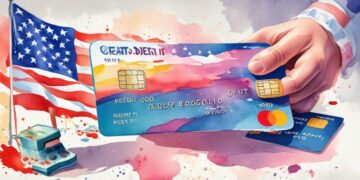How to Deal with Credit Card Debt and Avoid High Interest Rates

Understanding Credit Card Debt
Credit card debt has become an all-too-familiar aspect of financial life for many Americans. As lifestyles become increasingly reliant on credit, managing this debt effectively transforms into a critical skill. The good news is that with disciplined practices and informed decisions, you can regain control of your finances and work towards a debt-free future.
Know Your Balance
One of the first steps to managing your credit card debt is to regularly check your credit card balance. This simple practice allows you to avoid overspending and helps you stay aware of how much debt you’re carrying. For instance, if your credit card balance is $5,000 and your limit is $6,000, knowing this figure helps you maintain financial discipline. You can set a personal spending limit that keeps you well within your budget. Additionally, consider setting up alerts through your credit card provider to notify you of your spending and due dates, ensuring that you never miss a payment or inadvertently overspend.
Understand Interest Rates
Understanding interest rates is equally vital. Credit card companies typically charge high-interest rates, often exceeding 20%, which can significantly increase your total debt if not managed carefully. Knowing how interest accrues can also aid you in making more informed decisions about when to pay your balance. For example, if you carry a $3,000 balance with an 18% annual interest rate, you may pay an additional $540 in interest over the course of a year if you only make minimum payments. This knowledge empowers you to prioritize paying down balances with the highest interest rates first or to consider transferring high-interest debt to a card with a lower introductory rate to save money in the long run.
Create a Budget
Building a monthly budget is a powerful way to keep your finances in check. A budget allows you to map out your income versus your expenses, helping you identify areas where you can cut back. For example, if you spend $150 a month on dining out, you might choose to reduce that to $75 and use the extra funds to pay down your credit card balance. Furthermore, budgeting encourages responsible spending habits and can also serve to highlight any recurring subscriptions or unnecessary charges that might be adding to your debt.
In conclusion, taking control of your credit card debt starts with establishing good financial habits and being informed about how your financial tools work. By focusing on long-term solutions rather than quick fixes, you can chip away at what you owe while minimizing interest costs. As we delve deeper into effective strategies in the upcoming sections, remember that the journey to financial freedom is a marathon, not a sprint. Are you ready to take the first step toward improving your financial situation?
Strategies for Managing Credit Card Debt
Once you have a clear understanding of your credit card balances and interest rates, the next step is to implement effective strategies to manage your debt. Each approach will help you not only pay down your debt but also minimize the impact of high interest rates that can lead to financial strain. Below are some of the most effective methods to tackle your credit card debt.
Prioritize Your Payments
With multiple credit cards, it’s important to prioritize payments. This often means targeting the card with the highest interest rate first. By focusing your extra payments on this card, you will save money on interest charges over time. After that card is paid down, you can apply the same strategy to the next highest interest card. This method, known as the avalanche method, is effective for minimizing total interest costs. Alternatively, consider the snowball method, where you pay off the smallest debts first. This can be motivating as you see balances disappearing quickly.
Negotiate Lower Interest Rates
Another simple yet effective strategy is to negotiate with your credit card issuer. Many consumers are unaware that they can call their credit card company and request a lower interest rate. If you have a good payment history and have been a loyal customer, companies may be willing to lower your rate to keep you from transferring your balance to a competitor. Prepare for this conversation by researching competitor rates and be ready to present your case assertively.
Consider Balance Transfers
Balance transfer offers can be a helpful means to manage debt more effectively. Many credit cards offer promotional low or 0% interest rates for a specified period for new balance transfers. This strategy allows you to consolidate high-interest debts into one card, saving you money on interest while you pay down the balance. However, be cautious—balance transfer cards often impose fees, and if you don’t pay off the transferred amount before the promotional period ends, you could end up with a higher balance than before. Before proceeding, weigh the pros and cons and read the fine print to ensure it aligns with your financial goals.
Limit Future Credit Card Use
While working to pay down your credit card debt, it’s crucial to limit future credit card use. This might mean setting strict guidelines for yourself or even temporarily placing your cards in a drawer. Consider using cash or a debit card for purchases to keep your spending in check. Additionally, create a robust plan for future expenses, so you’re not forced to rely on credit cards again.
Implementing these strategic approaches to managing credit card debt can lead to significant progress on your path to financial stability. Remember, every small step counts and can lead to greater strides towards achieving a debt-free life. In the next sections, we will explore additional tools and tips to ensure you’re making informed decisions on your journey to effectively manage your finances.
Advanced Techniques for Reducing Credit Card Debt
In addition to the foundational strategies discussed earlier, there are advanced techniques that can further assist in managing credit card debt and avoiding high interest rates. Understanding and utilizing these methods can lead to a more effective approach to financial independence.
Establish a Budget
Creating a realistic budget is essential for tracking both income and expenses. By budgeting, you can allocate a specific amount of money each month to pay down your credit card debt. Use budgeting tools or apps to help you visualize your financial situation better. For instance, the 50/30/20 rule can be a practical approach where 50% of your income goes to needs, 30% to wants, and 20% to savings and debt repayment. When you see how much discretionary spending you have, it becomes easier to redirect funds toward credit card payments.
Use Debt Snowflake Method
In addition to the avalanche and snowball methods, consider using the debt snowflake method. This technique encourages you to make small, one-time payments towards your debt whenever you have extra cash available. For example, if you earn extra income from a side job or receive a tax refund, apply that money directly to your credit card balance. These small payments can accumulate over time and significantly reduce your debt quicker than you might expect.
Utilize Financial Counseling Services
If managing debt becomes overwhelming, don’t hesitate to seek help from financial counseling services. Nonprofit credit counseling agencies can provide personalized advice and help create a strategy tailored to your specific circumstances. They can also assist in negotiating with credit card companies for better terms. Importantly, ensure the agency you choose is reputable and accredited by the National Foundation for Credit Counseling (NFCC) or a similar organization.
Take Advantage of Employer Benefits
Many employers now offer financial wellness programs in their benefits package. These programs often include tools and resources for managing debt, budgeting workshops, and sometimes even access to financial advisors. Check with your HR department to see what resources are available to you that could assist in reducing your credit card debt.
Create an Emergency Fund
Establishing a small emergency fund can prevent the need to utilize credit cards for unexpected expenses, which can contribute to debt. Aim to save at least $500 to $1,000 initially. This financial cushion allows you to handle minor emergencies without reaching for your credit card, thereby making it easier to stay focused on your debt repayment goals.
Monitor Your Credit Report Regularly
Keeping an eye on your credit report is important to understand how your debt impacts your credit score. You are entitled to one free credit report per year from each of the three major credit bureaus—Experian, Equifax, and TransUnion. By reviewing your credit report, you can spot any inaccuracies that may be negatively affecting your score. Addressing these errors can enhance your creditworthiness and provide you with better access to financial products with lower interest rates in the future.
Implementing these advanced techniques will enable you to take a more comprehensive approach to credit card debt management. By combining various strategies, you can tailor a plan that works best for your financial situation, promoting a clearer path toward becoming debt-free. As you navigate your journey, remember that persistence and informed decision-making are key to achieving financial health.
Conclusion
Dealing with credit card debt can feel like an overwhelming challenge, but with the right strategies, you can regain control of your financial future. To effectively manage your credit card obligations, it is vital to adopt a holistic approach that encompasses budgeting, exploring advanced repayment techniques, and seeking assistance when necessary. Remember, creating a realistic budget that aligns with your income and expenses is the cornerstone of effective debt management. Additionally, utilizing methods like the debt snowflake approach allows you to leverage extra funds creatively while keeping your motivation high.
Moreover, tapping into professional resources such as financial counseling services can provide you with personalized guidance tailored to your unique financial situation. Embracing employer benefits that focus on financial wellness can add another dimension of support in navigating your debts. A small yet consistent emergency fund serves as a safety net, reducing the dependence on credit cards for unexpected expenses and thus preventing further debt accumulation.
Lastly, continuously monitoring your credit report empowers you to stay informed about your financial standing and enables you to catch any errors potentially impacting your score. Armed with this information, you can make strategic decisions that lead to lower interest rates in the future.
In summary, by combining diligent budgeting, advanced debt-relief strategies, and proactive management of your financial resources, you can tackle credit card debt effectively and work towards a future of financial stability. Remember, the journey to becoming debt-free is a marathon, not a sprint; with patience and persistence, greater financial health is within your reach.
Related posts:
How to Pay Bills and Services in the US Using Apps
The Ultimate Guide to Bank of America Travel Rewards Credit Card: Benefits, Features, and How to Max...
How to negotiate lower rates on student loans
How to Apply for the BankAmericard Credit Card: A Comprehensive Guide
Unleashing Financial Flexibility: A Comprehensive Guide to the Power Cash Rewards Visa Signature Car...
Unlocking the Potential of Unlimited Cash Rewards: How to Maximize Your Benefits

Linda Carter is a writer and financial expert specializing in personal finance and money management. With extensive experience helping individuals achieve financial stability and make informed decisions, Linda shares her insights on the Web Dinheiro platform. Her goal is to empower readers with practical advice and strategies for financial success.






